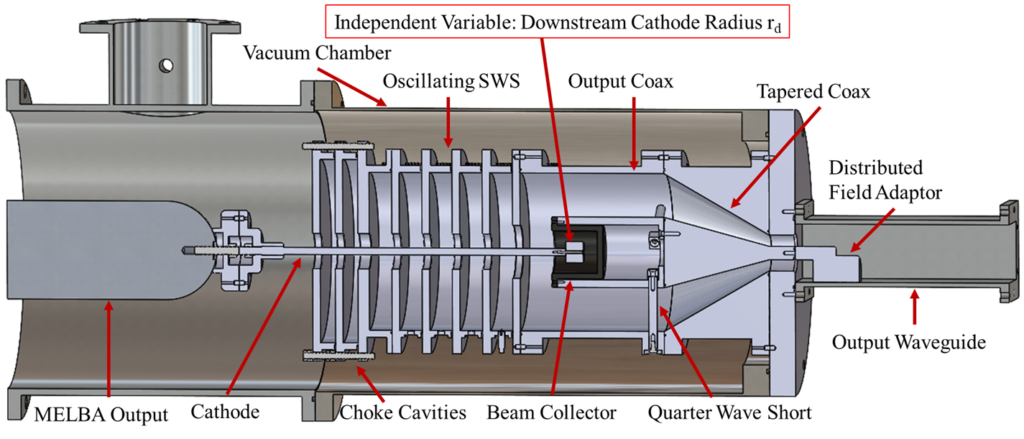The PPML studies High Power Microwave (HPM) sources for national defense applications including force protection, counter-electronics, vehicle stopping, radar, and countering drone swarms. This work, led by Professor Jordan, is largely conducted through the support of the Air Force Office of Scientific Research and the Office of Naval Research, and in partnership with the Air Force Research Lab and Naval Research Lab. As shown by our Past Graduates page, many of our students go on to careers at these (and other) national labs.
We use pulsed power drivers, typically Marx capacitor banks or linear transformer drivers (LTDs), to supply HPM sources with -300 kV voltage pulses at 1-10 kA for 200-500 ns. These HPM sources convert the kinetic and potential energy of this electron beam into microwaves at power levels of 100-1000 MW (the microwave oven in your kitchen uses a magnetron to produce 0.001 MW). Current research topics include coaxial multipactor, crossed-field amplifiers, relativistic magnetrons, and magnetically insulated line oscillators (MILOs). Information about past and present projects is provided below:
Coaxial multipactor simulation in CST Microwave Studio, showing multipactor evolution from a single seed electron (Stephen Langellotti, 2023)

Dual Recirculating Crossed-Field Amplifier (DRPCFA) particle-in-cell simulation in CST Microwave Studio. As the electron beam rotates counter-clockwise around the central cathode, spokes form and interact with the slow-wave structures on the top and bottom. The drift regions on the left and right provide demodulation to prevent oscillations from developing. (Chris Swenson, 2022)

CAD drawing of the L-band Magnetically Insulated Line Oscillator (MILO). MILOs use a strong axial electron current (10’s of kA) to generate an azimuthal magnetic field. In both MILOs and magnetrons, this magnetic field insulates the electron flow and prevents electrons from streaming across the anode-cathode gap. Magnetrons require an external magnet, while MILOs are able to generate their own magnetic field. As the electrons move along the cathode (left to right) they form bunches/spokes and generate an oscillating microwave signal on the slow-wave structure (SWS), which is then extracted by the tapered coaxial line and converted to a TE10 waveguide mode by the distributed field adaptor. (Drew Packard, 2020)

CAD model of the Recirculating Planar Crossed-field Amplifier (RPCFA). In experiments, the RPCFA generated 1-10 MW with up to 13 dB gain, 13% bandwidth, and a center frequency of 2.9 GHz. Microwaves are injected through the waveguide on the right, amplified by the RPCFA, and extracted by the waveguide on the left. (Stephen Exelby, 2019)
(left) CAD model of the Recirculating Planar Magnetron with All-Cavity Extraction (RPM-CACE). The Recirculating Planar Magnetron is a high power microwave source invented at UM which extends the typically cylindrical magnetron geometry to form two planar interaction regions on each side of the cathode (right). Microwave oscillations are extracted from each pair of cavities using coaxial cavities (numbered 1-6 above), and then extracted via six waveguides after passing through a coaxial-to-waveguide mode converter. (Matthew Franzi, 2014)
For a short summary of current Air Force Research Lab efforts in HPM, please see this recent MIPSE seminar by AFRL Senior Scientist (and PPML-alum) Brad Hoff.


